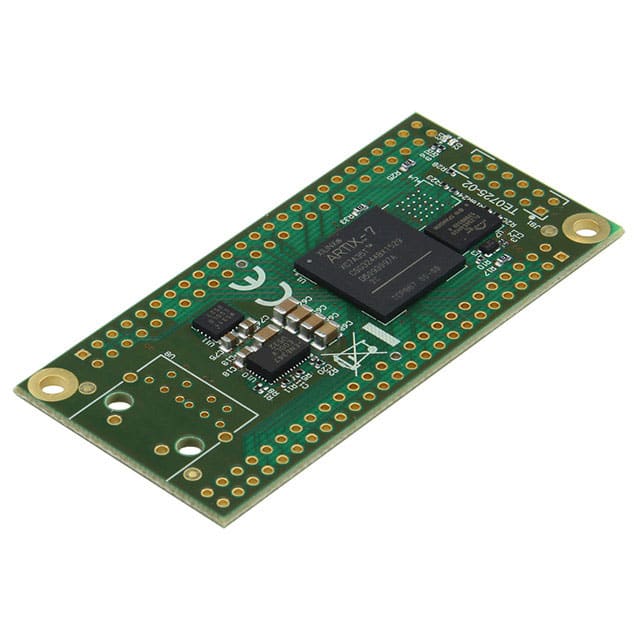Szczegóły produktu można znaleźć w specyfikacjach.

TE0725-03-15-1C
Product Overview
Category
TE0725-03-15-1C belongs to the category of electronic development boards.
Use
This product is primarily used for prototyping and developing electronic circuits and systems.
Characteristics
- Compact size
- High-performance capabilities
- Versatile functionality
- Easy integration with other components
- Robust design for reliable operation
Package
TE0725-03-15-1C comes in a standard package that includes the development board, necessary connectors, and documentation.
Essence
The essence of TE0725-03-15-1C lies in its ability to provide a platform for engineers and developers to create and test electronic designs efficiently.
Packaging/Quantity
Each TE0725-03-15-1C package contains one development board.
Specifications
- Microcontroller: [Specify microcontroller model]
- Clock Speed: [Specify clock speed]
- Memory: [Specify memory capacity]
- Input Voltage: [Specify input voltage range]
- Operating Temperature: [Specify operating temperature range]
- Communication Interfaces: [Specify available interfaces]
- Dimensions: [Specify dimensions]
Detailed Pin Configuration
[Provide a detailed pin configuration diagram or table, specifying the function of each pin.]
Functional Features
- [List key functional features of TE0725-03-15-1C]
Advantages
- High performance and reliability
- Versatile functionality for various applications
- Compact size allows for easy integration into projects
- Extensive documentation and support available
- Compatibility with popular development tools and software
Disadvantages
- Limited availability of alternative models
- Higher cost compared to some other development boards
- Steeper learning curve for beginners
Working Principles
[Explain the underlying working principles of TE0725-03-15-1C, including any key technologies or methodologies used.]
Detailed Application Field Plans
TE0725-03-15-1C finds applications in various fields, including but not limited to: - Internet of Things (IoT) development - Embedded systems design - Robotics and automation - Sensor integration - Prototyping and testing of electronic circuits
Alternative Models
- [Provide a detailed list of alternative models that offer similar functionality to TE0725-03-15-1C, along with their specifications and advantages/disadvantages.]
In conclusion, TE0725-03-15-1C is a versatile and high-performance electronic development board that offers engineers and developers a reliable platform for prototyping and developing electronic circuits. Its compact size, extensive functionality, and compatibility with popular tools make it a valuable asset in various application fields. While it may have some limitations, its advantages outweigh the disadvantages, making it a preferred choice for many electronic design projects.
Wymień 10 typowych pytań i odpowiedzi związanych z zastosowaniem TE0725-03-15-1C w rozwiązaniach technicznych
Sure! Here are 10 common questions and answers related to the application of TE0725-03-15-1C in technical solutions:
Q1: What is TE0725-03-15-1C? A1: TE0725-03-15-1C is a specific model of a system-on-module (SoM) developed by Trenz Electronic. It is designed for use in embedded systems and provides various functionalities.
Q2: What are the key features of TE0725-03-15-1C? A2: TE0725-03-15-1C features an ARM Cortex-A9 processor, FPGA fabric, DDR3 memory, Ethernet connectivity, USB ports, and various I/O interfaces. It also supports Linux and other operating systems.
Q3: How can TE0725-03-15-1C be used in technical solutions? A3: TE0725-03-15-1C can be used as a core component in various technical solutions such as industrial automation, robotics, medical devices, IoT applications, and more. Its versatility allows it to be integrated into different projects.
Q4: What programming languages can be used with TE0725-03-15-1C? A4: TE0725-03-15-1C supports programming in C/C++, Python, VHDL, Verilog, and other languages depending on the target application. The choice of language depends on the specific requirements and software ecosystem.
Q5: Can TE0725-03-15-1C be customized for specific applications? A5: Yes, TE0725-03-15-1C can be customized to some extent. Trenz Electronic offers customization options for the SoM, allowing users to tailor it to their specific needs by adding or removing certain components or interfaces.
Q6: What development tools are recommended for working with TE0725-03-15-1C? A6: Trenz Electronic provides a range of development tools and resources for working with TE0725-03-15-1C, including software development kits (SDKs), reference designs, documentation, and support. Additionally, popular IDEs like Xilinx Vivado can be used for FPGA development.
Q7: Can TE0725-03-15-1C communicate with other devices or systems? A7: Yes, TE0725-03-15-1C supports various communication interfaces such as Ethernet, USB, UART, SPI, I2C, and GPIOs. This allows it to communicate with other devices or systems in the overall solution.
Q8: What is the power consumption of TE0725-03-15-1C? A8: The power consumption of TE0725-03-15-1C depends on the specific use case and the load on the system. It is recommended to refer to the datasheet or consult with Trenz Electronic for detailed power consumption information.
Q9: Is TE0725-03-15-1C suitable for real-time applications? A9: TE0725-03-15-1C can be used in real-time applications depending on the specific requirements. Its ARM Cortex-A9 processor can handle real-time tasks, but additional considerations may be needed for critical timing constraints.
Q10: Where can I find technical support for TE0725-03-15-1C? A10: Trenz Electronic provides technical support for TE0725-03-15-1C through their website, including documentation, forums, and direct contact options. They can assist with any questions or issues related to the module.

